



Dang it, SMSL! Would you ever stop for a moment and let us catch our breaths? You went ALL-IN with the second-generation VMV line-up outdoing yourself and outwitting your competition with D1SE and D2 that were accurate yet natural-sounding converters. You go out for a drink and come back with a bang, releasing the SU-10 which is still…the best D/A converter we tried below the $1K mark.
Things got peaceful after the SU-10 release, it was quiet…maybe too quiet. As the calm before the storm, you came back with two D/A converters that will be mudding the waters yet again below one kilo buck. D400ES was equipped with brand-new ESS-Sabre silicon which spots an MQA decoder in the same chip (ES3039MSPRO) but has similar performance numbers to the good old ES9038 PRO. D400EX on the other hand was more interesting to us, retrofitted with brand-new AKM4499EX silicon working in a dual mono configuration in conjunction with a delta-sigma modulator, which in theory should unlock the true potential of AKM’s best. A very similar configuration can be found in a pricier $1500 Gustard A26 which we tested not too long ago, with the exception that SMSL dropped the price to a more attractive $959, dropping the mic for its competition & fighting only against their SU-10 converter.
I’m greeted with a beautiful-looking case, which isn’t a common sight when talking about SMSL Audio. I see nicer metallic feet, massive heatsinks on its sides, every possible digital input and analog output is on board, plus there’s a decent component selection. As usual, I will be conducting a comprehensive review in a stereo and headphone setup and a mandatory comparison between D400EX and SU-10 will follow shortly. Before I move on to sound impressions, let’s take a look at the unit itself and check what’s the catch with the newest SMSL D400EX DAC.
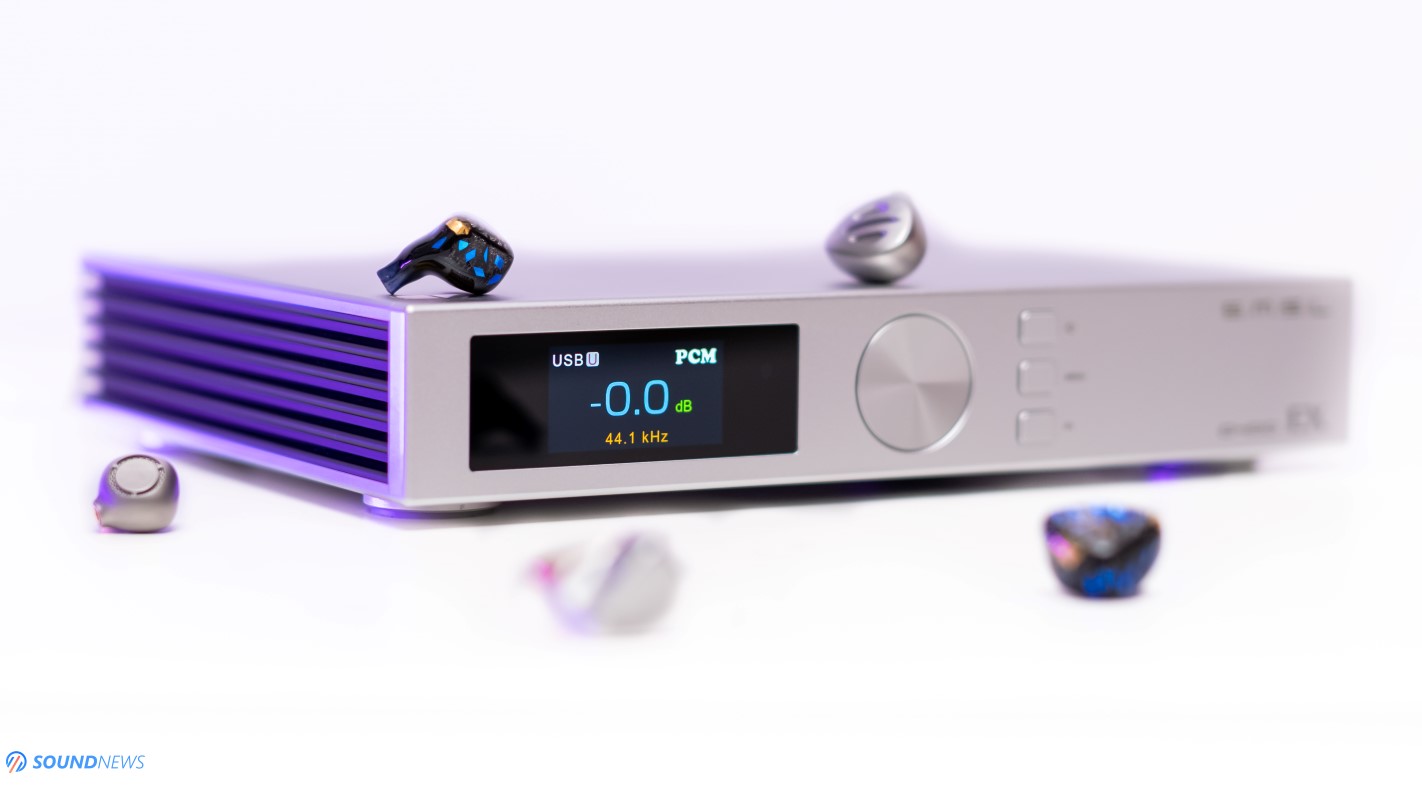
Design & Build Quality
While I dig the looks of D400EX, D400ES, SU-10, and of their entire VMV line-up, I dislike that SMSL is not sticking with a design for several generations. When I’m at a HiFi show I can spot from afar all audio brands that are being used and it would be cool if SMSL would pick a design and stick with it as brand identity is important. D400EX looks clean, simple, and straightforward without bells and whistles attached to it…but I still like the cleaner look of their SU-10 and I believe that’s their best design yet.
D400EX looks fantastic and in some ways, it reminds me of the newest Matrix Audio creations, having a silver anodized body with matte black heatsinks. Other than that, D400EX was built with thick metallic plates on all sides, crafted on CNC machines, polished with a fine grain, and sprayed with beautiful silver paint that adds a future-fi flavor. The only things I dislike about it are those unnecessary buttons that could be bypassed (as their SU-10 does) by using the included remote control, but that’s mostly nitpicking on my part. In a stereo rig, I can’t see them and its bright & colorful display offers good visibility even from two and a half meters away.
All in all, I can’t say a single bad word about its build quality. It’s well-made, built at high standards, small and cute, and at ~1.85 kilos (~4 lbs.) it feels solid enough. It is only a hair bigger than the SU-10, but you can still place it in super-tight spaces, in a killer headphone or stereo setup, you can hide it below your TV, gaming console, or media player, thanks to a small footprint, and miniature case.
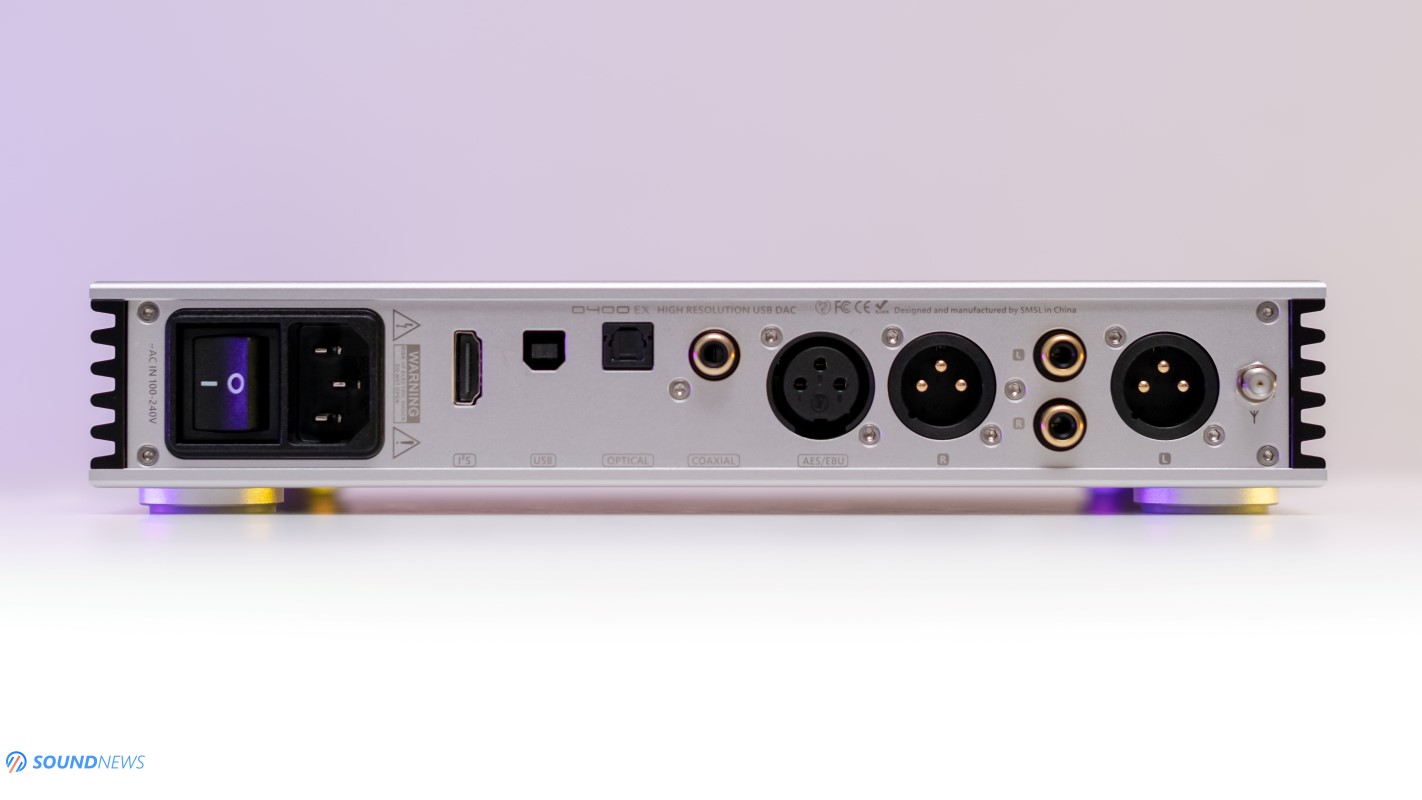
Controls & I/O
It has a simple front panel with a colorful screen located to the left, a volume wheel/menu navigator sits exactly in the middle and three additional buttons were moved to the right that lets you choose a desired digital input, analog output, or engage its graphical user interface.
On its back, you can find a wide variety of digital inputs such as USB Type-B, Optical, Coaxial, AES, and I2S via HDMI. There’s a Bluetooth antenna socket as well and since I’m describing a fully balanced DAC, it offers a pair of XLR and RCA outputs offering a variable or fixed voltage output depending on the settings.

Menu Options
It has an advanced graphical user interface and luckily, you can control that via its remote control or volume wheel that doubles as a menu navigator. A single press on the menu button will enter its GUI where the following settings can be accessed:
Input – USB, Bluetooth, Optical, Coaxial, AES/EBU, and I2S (HDMI).
Outputs – All Line-Out, Balanced (XLR), or Unbalanced (RCA).
PCM Filter - you can select a desired digital filter working on a hardware level with the DAC chips themselves. There are six filters to play with, but the sound difference is slight at best. I’m using Sharp Roll-Off.
DSD Filter – Wide or Narrow. For the most extended sound choose Wide, for the most relaxed sound choose the last option.
Sound Color – Four options are being provided, but I like the default one the most. If you would like to alter its tonality, then this would be your playground.
PRE Mode – Variable, Fixed, or Fixed DSD Bypass. If you will be using it as a DAC-only unit, leave it at Fixed.
FN Key for – Outputs, Bluetooth, or Phase. You are choosing the function of the FN button.
I2S Mode – Normal or Reversed.
I2S DSD Channel – DSDL = PCM Data or DSDL = PCM LRCK. For points 8 and 9, please check its user manual if you are willing to try a few DDCs or wireless streamers via the I2S input.
Audio Phase – Normal or Inverted.
Dimmer – Dims its screen from 5 to 60 seconds, the OFF position leaves it powered on.
Brightness – 6 brightness positions.
Reset – Goes back to factory settings.
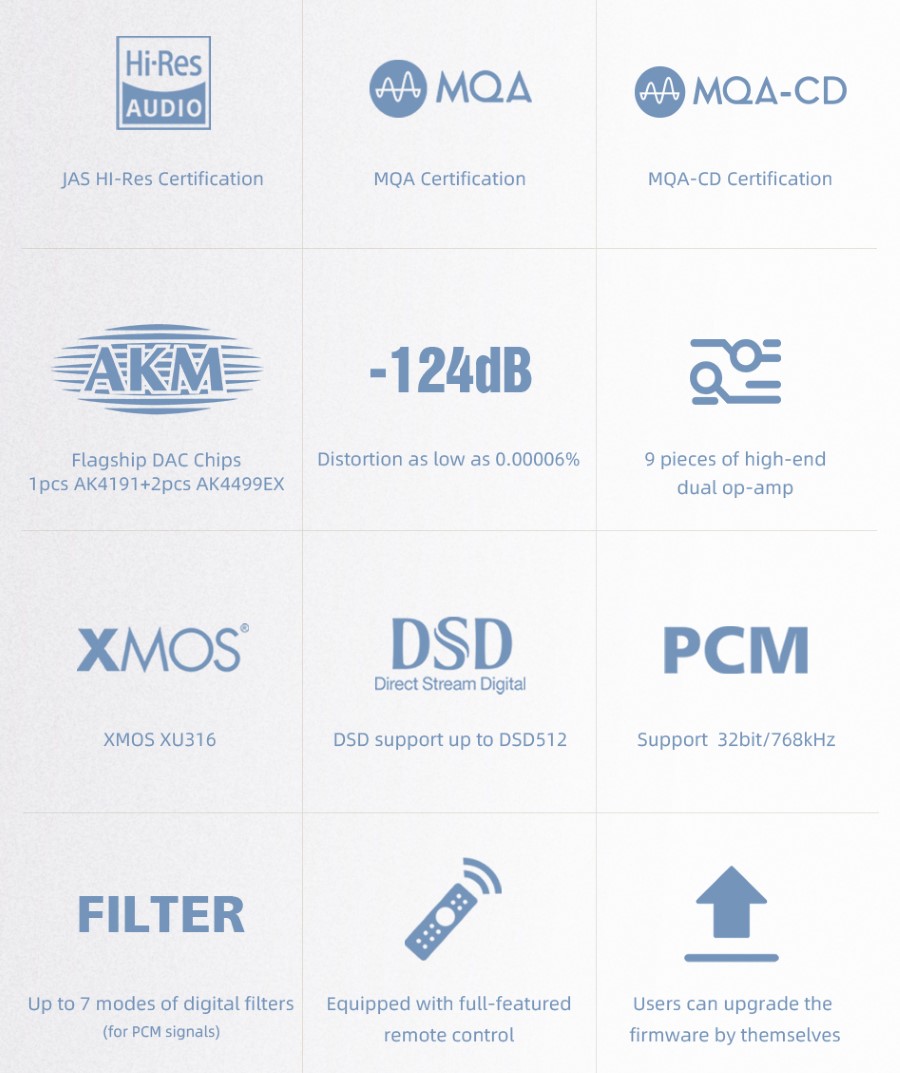
Under the Hood of D400EX
I’m not sure what holds it together, as after removing all the screws I was unable to open it up, so I’ll stick with the information provided by the manufacturer.
As opposed to SU-10 which uses ESS-Sabre silicon, we are dealing with an oversampling unit that uses the newest and highest-performing silicon of Asahi-Kasei Microdevices, or AKM for short. AK4499EX superseded the AK4499EQ in Q3 2022 as their best one yet. Compared to its older 4-channel sibling, the newest silicon is a dual-channel one. This particular silicon offers a slightly better dynamic range when used in dual-mono mode and that’s exactly what SMSL employed in their D400EX. The newest silicon no longer has an internal delta-sigma modulator, meaning that an additional chip will be needed for that specific task. AKM recommends the AK4191 modulator as being the best match, specifically designed for AK4499EX and again we can spot it on the digital board. In simpler words, what a single AK4499EQ chip could do a few years ago was moved into three separate devices, two AK4499EX and a single AK4191 used as a premium delta-sigma modulator. Since every chip does its own thing never be bothered with additional tasks, the noise floor and distortion lowered, and the sound should be faster and more accurate than ever before.
There’s a brand new XMOS receiver released last year (XU-316) that’s currently the most powerful off-the-shelf digital receiver of today. We’re talking about a 16-core chip with up to 2400 MIPS and 1200 MFLOPS of processing power that unlocked MQA playback via its USB input.
Respectable DAC makers from China already developed their clock management chips (see Gustard, Aune, and Topping) and it seems that SMSL followed the same course of action, developing their CK-03 clock management unit that was encapsulated for better noise rejection and stable working temperature.
I’m a little sad that SMSL dropped the overkill analog output stage of SU-10 and instead of 21 dual op-amps, they went with 9 operational amplifiers which will be controlling the current and voltage flow. From linear transformers, SMSL went back to switching mode power supplies made by Mornsun. I see two of them, most likely one is powering the digital section and the other one the analog output stage. The power supplies are filtered with Nichicon capacitors and regulated with several voltage regulators for optimal performance.
A Qualcomm Bluetooth receiver is on board that supports the nicest codecs available as SBC, AAC, AptX, AptX-HD, and LDAC. Its antenna works as a wireless booster and its operating distance should be around ~10 to 15 meters, depending on how many walls are in between it and the sender.
All in all, SMSL used the best AKM implementation as of yet similar to that of the Gustard A26 and I’m already expecting a matching performance. A few compromises were made to achieve the desired price points and let’s check if it performs well.
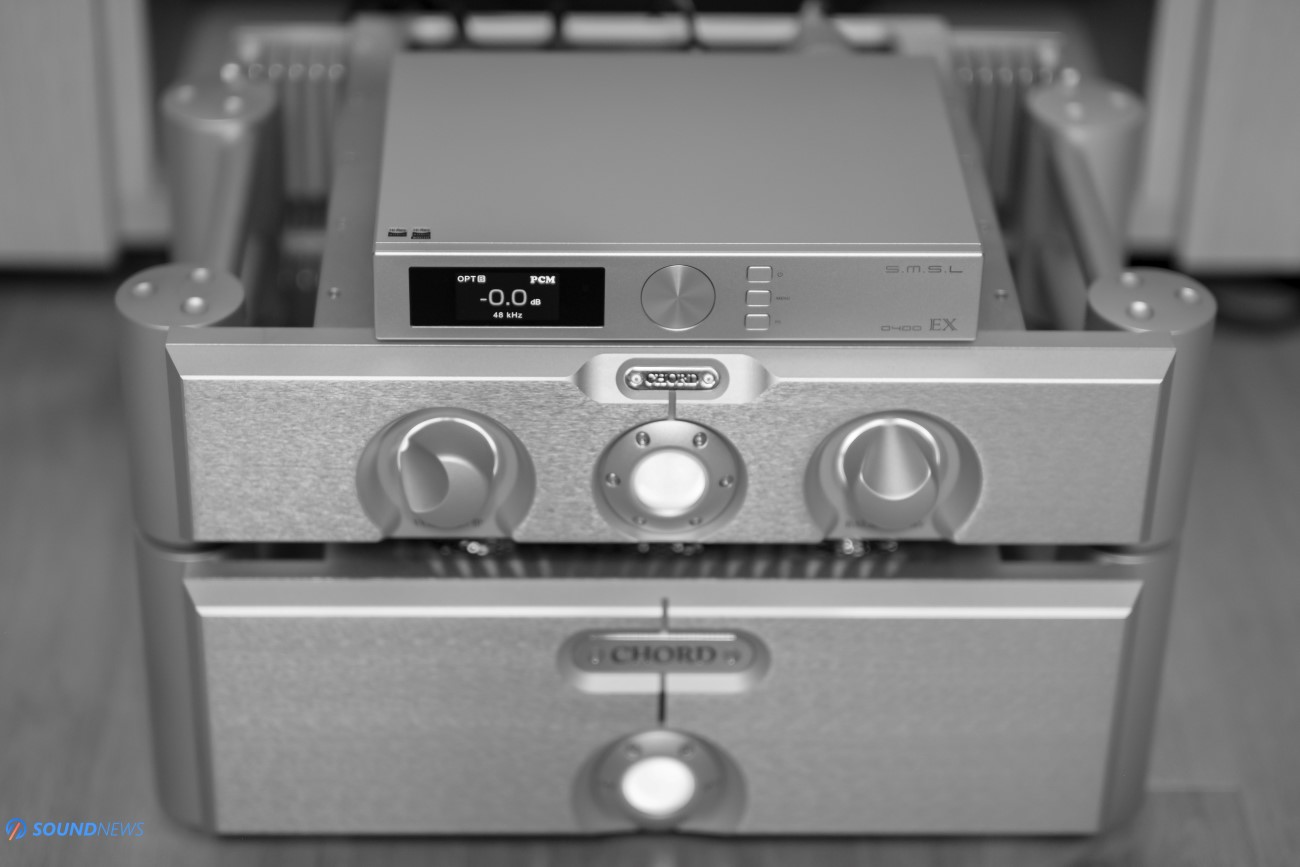
Test Equipment
I’m testing D/A converters in stereo and headphones setups, so I can have a better feel about them.
In my main headphone setup, D400EX was connected to a Trafomatic Primavera, Topping A90D, or SMSL HO200 driving all sorts of headphones from affordable to high-end cans. Hifiman Susvara was used the most, followed by Meze Elite, Kennerton Rognir, and Sennheiser HD800S.
In a stereo setup, it worked as a DAC, followed by a Chord Ultima 3 preamp and by a Chord Ultima 5 power amp and I also used it as a DAC and Preamp combo, just in case you’ll be using it this way in tandem with a power amplifier. I used Musician Knight 1 stand-mounted speakers on several occasions, but my KEF Reference 3 stand floors were used a lot more as I find them more resolving and holographic sounding by a good deal. Everything worked in the balanced mode for a lower channel cross-talk and a higher dynamic range.
All right everybody, this is pretty much it, so let’s hit some eardrums!

Sound Performance
I. Preliminary Impressions
After testing Gustard’s newest A26 DAC, which proved that the newest AKM silicon can be both technical and natural sounding, I set my expectancy levels high as D400EX rocks a similar implementation, except the power supply and analog output stage.
Performance-wise, SMSL’s newest unit is mixing the tonality of their former VMV D2 high-end DAC with some of the technical performance of Gustard’s A26. I can hear a few similarities with A26, with the exception that SMSL’s unit doesn’t care as much for technical performance. Transparency, detail retrieval, and depth went down by a notch, but the pleasure of listening to music remained unspoiled, putting a bigger accent on the midrange delivery, gently slashing the upper treble energy, especially the treble glare and listening fatigue.
Looking back at VMV D2 which set the bar as the smoothest and warmest sounding unit that passed through my hands, never trying to bother with crisp highs or punchy bass notes, it seems that SMSL went with similar ideas, as D400EX is devoid of any aggressiveness, trying to show only the beautiful side of your tunes. SMSL no longer makes the VMV D2, but if you want an updated version that rocks a similar performance at a much more affordable price, then SMSL’s D400EX looks like a worthy successor.
SMSL’s SU-10 seems like a different animal though and let me explain what are the major differences. SU-10 puts a higher accent on the technical performance, always running like an athlete, proving an outstanding transient response and detail retrieval. SU-10 is ruthless with less-than-perfect recordings, it’s incredibly clean and transparent, always delivering the full force of sub-bass notes and snare drum hits. It’s considerably more aggressive sounding which works better with modern tunes but not so much with half-century recordings. Compared to that, D400EX is slowing down the pace, it doesn’t rush to the finish line and lets you better process the information with longer decay of the notes, leaving an audible trail with acoustic music. D400EX is more gentle sounding and it won’t deliver you the full might of the thunder god, although it pours more naturally with acoustic music. It offers denser textures and a longer vibration of the string instruments that will surely catch your attention with a fuller-bodied presentation, compared to an ultra-linear one of the SU-10.
It’s compelling knowing that SMSL gives us two options to choose from. You either get an extremely technical and linear-sounding unit or a less technical, but fuller-bodied sounding fellow that offers you a stronger midrange and mid-bass at the cost of a less extended treble delivery. Honestly now…SU-10 is more to my liking, as it follows my strict rules of covering all and everything, never slowing down on fast tunes, but I can see the beauty of the D400EX especially when acoustic music starts playing. I’m scratching my head why SMSL dropped the dual linear transformers of SU-10, followed by a robust analog output stage (21 op-amps!), going back to a switching mode power supply and less beefy output stage, but I guess they wanted to achieve a different sound that wouldn’t tesla coil your nerves and I believe they achieved their goals.

II. SMSL D400EX in a stereo setup
This chapter will feel like a déjà vu, as SMSL went again with the same digital attenuator which can be found in most SMSL devices released by now. There isn’t a preamp stage onboard, nor an analog volume attenuator. It can work in either fixed mode (full power ~4.7V via XLR) or variable mode which will digitally attenuate the signal.
I no longer have integrated amplifiers by my side, but I guess D400EX will work better with those as you won’t need to use its built-in digital attenuator. If you’re rocking power amplifiers as I do, then without a dedicated preamp in between the D400EX and your power amp, there would be a small degradation of transients, slowing down dynamics and sucking out the life from the music. When I connected it directly to a Chord Ultima 5 power amplifier driving a pair of KEF Reference 3, the sound stage wasn’t as expansive as I know it to be and the music wasn’t filling every corner of the room. The sound wasn’t emanating behind the TV as it usually happens with the Chord Dave and from a full 3D imaging, the sound felt two-dimensional with little to no depth or weight to it.
After adding a Chord Ultima 3 preamp and letting D400EX as a DAC-only unit…there was a sizable difference sound-wise. The stage widened substantially, depth gained a few layers, dynamics improved by a whole lot and weirdly, I felt better control of my loudspeakers. It was like replacing a rusty engine with a brand-new one that was revving like crazy. From anemic and polite, the music became visceral and impactful, dynamics were much jumpier, a clear sign that its internal volume control was put there mainly for convenience and not for high performance. When Draw Your Swords by Angus & Julia Stone (Qobuz / Tidal) started playing, I felt weightier voices and a stronger authority of the acoustic guitar. The sound felt free from the boundaries of my room while being tighter and more focused this time around.
My recommendation would be to use integrated amplifiers or a Pre + Power setup with D400EX used in fixed mode. The difference between using a preamp and not using one was bigger versus their SU-10 and I can only presume that 21 op-amps were somehow pushing dynamics better, but that’s just an educated guess at this point.
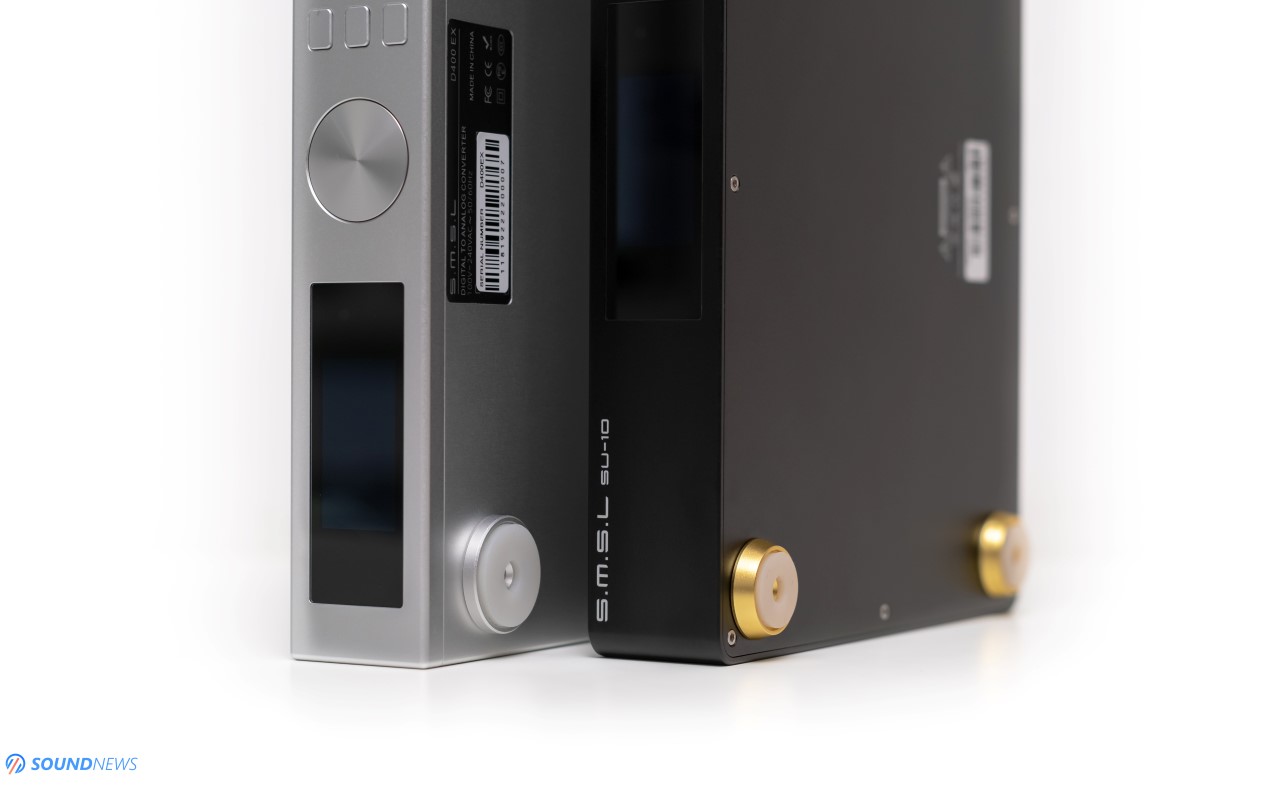
III. Detail Retrieval & Transparency
If I would complain a bit about D400EX’s performance, then that would be about its resolving abilities which were fine, but not particularly outstanding. I’m not sure what makes those ESS-Sabre-based D/A converters so controlled, focused, and detailed sounding, but D400EX can’t reach similar heights that SU-10 reached a few months ago. SU-10 wasn’t only technical and resolving, but probably the cleanest sounding unit we have tried up to ~$1400. The newest AKM silicon, especially the dual-AK4499EX configuration is no slouch either and Gustard proved that excellent detail retrieval can be obtained with their A26 DAC at $1500. As I have explained many times by now, component selection is crucial, especially things that are surrounding the DAC chip and I believe SMSL did a good job here, squeezing an impressive dynamic range of 131 dB via XLR outputs. If you’re crazy about your tunes on a micro-scale, then you’ll hear a good deal of nuances, as the limiting factors would be your music, downstream equipment, and your hearing apparatuses.
While SU-10 and their former VMV D1SE were bringing forward information in a more aggressive manner, making several tunes almost unlistenable, D400EX brings forward that info more naturally without shooting high-velocity needless at higher registers. D400EX won’t add an over-sharpness filter on top and its treble output feels way more relaxed to a point of rolling off a small portion of it. There is less ringing and subsequently, it makes you feel that the treble isn’t as clean or defined. Listening to old rock tunes that have imperfections and mastering errors, never felt offensive but groovy and pleasing. D400EX isn’t a brutally honest sounding DAC as on treble-intensive tracks it tamed the top-end and made it manageable, especially via bright tilted speakers and headphones.
I’m always on the hunt for new information buried deep behind my tracks, I like re-discovering new things and with D400EX by my side, it wasn’t a challenge searching for small intricacies, but those didn’t feel overly exaggerated as it was the case on the SU-10. I also have an SMSL C200 and DO200 MKII by my side which are awaiting their turn and after playing with all three, there was quite a jump in resolution when swapping from C200 to DO200 MKII and then to D400EX.
When Beast (Extended Version) by Nico Vega (Qobuz / Tidal) appeared on my playlist, I was already preparing to take off the Hifiman Susvara and put Erzetich’s latest Charybdis in their stead, but lo and behold, D400EX driving the Trafomatic Primavera completely bypassed the aggressiveness of this track. Dynamics felt explosive, I was air drumming like crazy & humming (more like shouting) alone in my office. It brought a good dose of dopamine and a smile to my face as I could listen to cymbals and snare drums all day long without lowering the volume. D400EX provided good transparency levels and I could follow the drummer going crazy in the background, analyzing the tiniest sounds that materialized before my eyes.

IV. Transient Response
Their SU-10 was a lightning-quick sounding unit and it impressed me more with bass quality, rather than with bass quantity. This time around SMSL changed the rules of the game, putting a higher accent on quantity, and getting a higher midrange and mid-bass presence at the cost of a slower overall sound. When the SU-10 felt like a hypercar, cruising at illegal speeds on the highway, D400EX felt like a Cadillac riding smoothly at slower speeds with the roof open. D400EX won’t go in and out in a flash with electronica tunes, nor will it handle double drums as Igor Cavalera. On the flip side, musical notes carried lots of weight and substance.
I’m pretty sure Chord’s Ultima 3 Pre + Ultima 5 Power adds a lot of energy into the mix, but lots of weight and textures are still coming from within D400EX’s driving power. SMSL’s latest DAC will impress a little more when landing powerful hits on your eardrums and less with quick shifts in terms of dynamics. It doesn’t fight in the lightweight boxing category but in the heavyweight category, pounding harder than its smaller siblings (DO200 MKII and C200) at the cost of a slower transient response. SU-10 better suits my tastes and my listening habits, but I can understand why people would choose the D400EX to the detriment of a more aggressive-sounding SU-10. My blood boils when I’m listening to music and I can’t multitask or write articles when I’m in a Nirvana state…but I feel that I can do that with the D400EX on my table. It relaxes my brain and lets the music flow at slower speeds, which works as a magic pill with mellow and relaxing music. In this regard, it resembles the sound of VMV D2, which didn’t feel like a feet-dancing Vasyl Lomachenko and more like a hard-pounding Mike Tyson in its presentation.
When Ashes Of the Modern World by Apocalyptica (Qobuz / Tidal) started playing, I appreciated the added warmth and weight of the cello, working as an energy bar for six minutes and a half, being overwhelmed by the layering, depth and by her majesty, bass slam! Those were still cellos, but they sounded electrifying and much heavier than what I was expecting.

V. Soundstage & Imaging
It seems that we didn’t get a super-fast or highly resolving sounding unit, but when it comes to scaling and layering, this thing eats ESS-Sabre devices for breakfast. D400EX is impressive here, even more so compared to their SU-10 and VMV D1SE and it’s on another level compared to DO200 MKII and C200. It approached the layering and airiness of Gustard’s A26, but it is still not exactly on the same level, as A26 will still portray a bigger picture in front of me. Usually, this is where AKM-based units are shining and D400EX didn’t disappoint a single bit. Live recordings were expanding my listening space while broadening the sweet spot on the sofa. Even crowded music felt at peace and I could easily focus on anything. It pushes midrange and mid-bass forward and everything else took a step back which was felt with speakers and headphones alike. Adding a Trafomatic Primavera and then a pair of open-back headphones felt like broadening the stage of said headphones, making them a tad wider and deeper sounding. The usual listening fatigue that I’m getting from fast-paced music was no longer happening, music wasn’t cramped inside my head anymore, never interfering with my private space. I’m using higher-performance DACs daily, but D400EX didn’t feel shy in the company of much pricier DACs, especially on things like imaging and scale.
Putting it into a headphone setup, using Matrix X-SPDIF3 as a digital transport, followed by a Trafomatic Primavera, I didn’t feel a major difference in terms of scale and imaging versus pricier converters. The whole experience felt airy & holographic and music wasn’t pushed inside my head. I was at peace and relaxed and it made me feel great. Even a few IEMs sounded like semi-open desktop headphones and D400EX impressed a bit more with its depth and imagining rather than with its resolving abilities.
SMSL went with the best configuration that AKM recommends and more exactly with two AK4499EX and an AK4191 working as a delta-sigma modulator, which led to an impressively high dynamic range of 131 dB and super-low distortion of 0.000053%. While channel crosstalk isn’t mentioned anywhere, it feels like it is lower than -100 dB as no matter how high I was raising the volume, I didn’t hear both channels mixing.
I went to a friend a few days ago to try out his end-game stereo setup and out of the blue Draw Your Swords by Angus & Julia Stone (Qobuz / Tidal) starts playing. We ate our tongues as an eerie silence covered the listening space. We were shocked by how airy and vast this track sounded. It felt like a distant memory and a vision of the future at the same time. The string arrangements, drums, and bass solos were somewhat predictable but having said that, I couldn’t deny the pure beauty and conviction of both Angus’s and Julia’s voices. They were beautiful singing on their own and together. The vocal melodies were lush, beautiful, and smooth. I was surprised by how much air a single voice could bring into the listening room and while this album isn’t that special as a whole, the empty spaces in between their voices and the rest of the sounds were huge.

Frequency Response
VI. Bass
SMSL went with a strong bass performance that focuses more on quantity rather than on quality. It’s a force to be reckoned with when drum & bass tunes start playing. It doesn’t have a snappy, lightning-fast, or tightly controlled bass, but it will impress with its brute force and painful hits. Mid-bass felt overblown at times and it’s elevated by a few dB from linearity, but that can have a beneficial effect on your setup. For example, it added body and texture after connecting it to an SMSL HO200 headphone amp – which on its own is almost sterile and emotionless sounding. D400EX worked excellently with neutral or bright tilted setups, planting more life in the bass and midrange at the cost of a lesser treble delivery. Its low-end was weighty & emphasized, easily reaching and maintaining 20 Hz notes. Bass notes went down to subsonic levels, it rumbled and raised my mood and that’s all you need to know about it.

VII. Midrange
Traditional delta-sigma converters aren’t offering an excellent timbre of the midrange and a full-bodied sound. Usually, that’s reserved for expensive R-2R and FPGA converters. Nevertheless, AKM-based D/A converters were able to impress a jazz and blues addict like me. I guess their Velvet Sound Technology and newly developed switched resistor tech planted a lot of life in the midrange. So much so, that I believe this is the most beautiful part of the D400EX performance. Its midrange stands out more often than any other region, it feels pushed forward a bit so most of the spotlights were moved to this region. D400EX got an excellent flow, it puts plenty of meat on the bone and you’ll feel its midrange organic and life-like sounding. It’s fuller-bodied to say an SMSL SU-10 or VMV D1SE and it goes in the same direction with their VMV D2 and with most R-2R DACs. If you are in love with the midrange region and an R-2R DAC is still out of your league, then SMSL’s latest unit can offer a similar experience at a more affordable price. Midrange comes in higher doses than usual and it’s one of those units that I would call as creamy, sweet, and warm sounding, boosting the energy of the midrange.

VIII. Treble
D400EX transitions from midrange to treble slowly. Treble notes are reaching their peaks and a good deal of nuances are appearing in my tracks, but this fellow isn’t trying to overdo the treble region. It feels relaxed in here, sometimes too relaxed, as some spark and bite are missing. Snares don’t provide a fast thump and cymbals don’t have the sharp zing, partially removing some energy. It’s not smearing detail, but trebles lack sharpness and definition, to a point of calling it rolled off in here. D400EX is a polite-sounding unit and it won’t bother you with sharp trebles, not even put on bright-sounding amplifiers, speakers, or headphones. It almost feels like SMSL hid a vacuum tube somewhere in there that removed all remaining traces of digitus and listening fatigue. In this regard, D400EX has nothing in common with its SU-10 sibling, which was strong, defined, extended, and sharp sounding in the treble. As a whole, SMSL D400EX pushed forward the mid-bass and midrange and it rolled off the top octave for relaxed listening sessions.
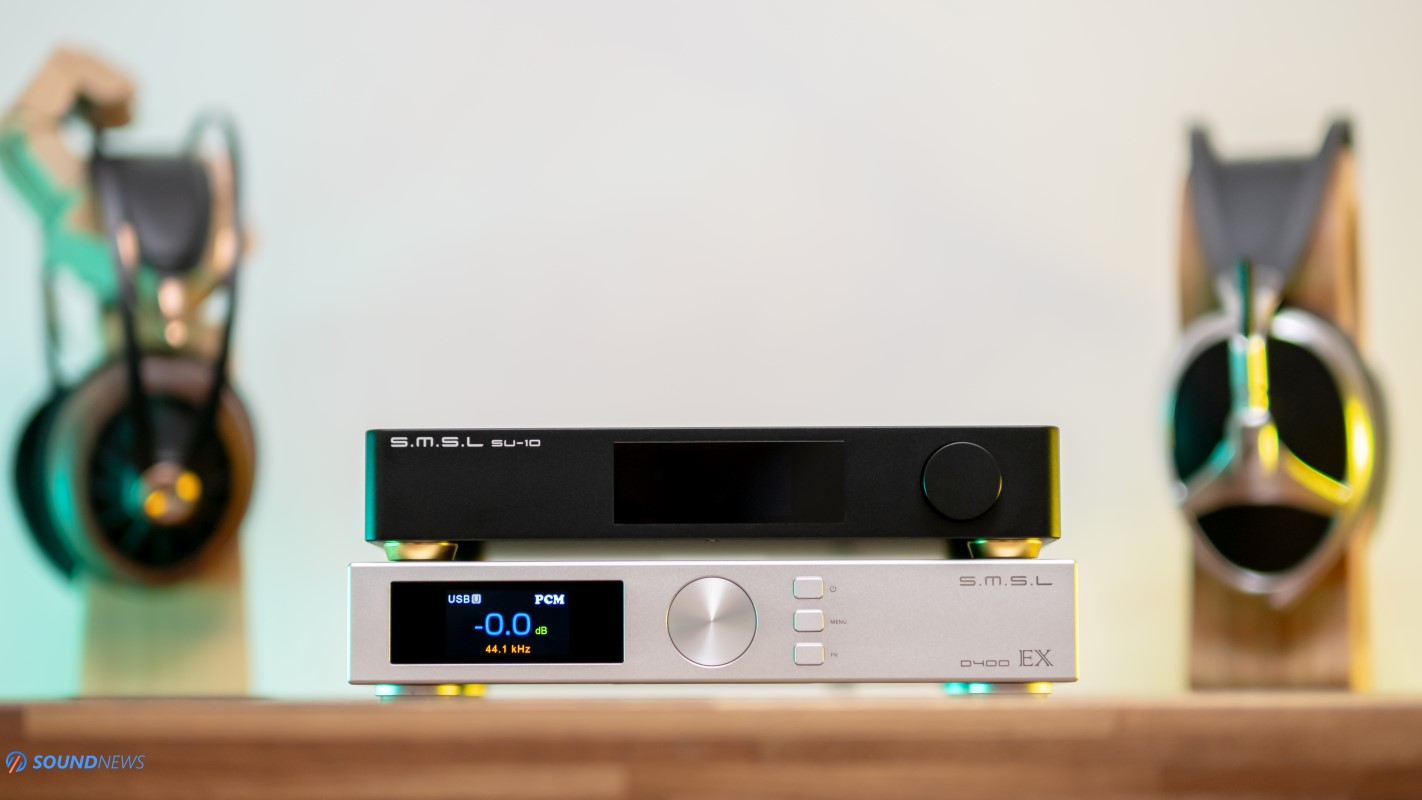
IX. An Important Comparison
SMSL D400EX ($959) VS SMSL SU-10 ($899)
Build quality-wise, both units are carved on CNC machines with very tight tolerance numbers, they both look and feel like expensive units. Although in terms of looks, I’ll give an edge to the SU-10 which looks sleeker and more elegant. They have a similar footprint, weight & high-quality craftsmanship, I just find SU-10 simpler as there aren’t buttons on its front panel.
When it comes to features, both are going neck and neck as everything that can be found on SU-10 made its way into the D400EX, with the exception that SU-10 adds a USB type-C port so you can hook it up to your smartphone or laptop in a jiffy. On the inside things are considerably more interesting as besides rocking top-of-the-line ESS Sabre silicon on SU-10 and equally impressive AKM silicon on D400EX, there are some things that I find more interesting on SU-10. For example, SU-10 is being powered by two custom linear and regulated transformers (one for the digital conversion and one for the analog output stage) which on paper should perform better than the switching mode power supplies inside the D400EX. Another thing that excites me more about SU-10 is the analog output stage which consists of 21 OPA1612A op-amps versus 9 dual op-amps used in the D400EX.
I won’t describe their inner workings furthermore as you have a dedicated article for the SU-10 right here. I needed to volume match both units and I was able to do that with the help of a MiniDSP EARS and my preamp which offers multiple inputs and output. D400EX provides a steady voltage of 4.7V, while SU-10 provides a slightly stronger 5.1V output. After volume matching both, I used the same power cables, and interconnect cables & the rest of the system remained unchanged, doing my tests blindly with the help of my beloved.
The first thing that struck me was their resolving abilities. While D400EX didn’t feel muddy or veiled sounding in any way, SU-10 provided a little bit more, especially in the lower and upper octaves. I found the sub-bass and upper treble cleaner sounding on the SU-10, improving their quality along the way. I can compare SU-10’s resolving abilities with some of the best DACs I have ever tried, but sadly, I cannot write down the same words about the D400EX. Besides putting more information on the table, SU-10 sometimes tries too hard, adding sharpness, which was missing on D400EX. The leading edges were much stronger on SU-10 and I felt them less defined, smoothed out, and calmer on D400EX, sounding more like digital vinyl rather than like a Hi-Res DAC.
Moving on to transients, it seems that D400EX was again outperformed by the SU-10, which felt agile and nimble sounding at all times. It switches gears in nano-seconds and it raises dynamics higher, it’s a joy listening to fast-paced music on SU-10 and to super high dynamic range tracks. Due to an impressive analog stage, the low-end is stronger and more impactful, always getting those 20-25 Hz notes like it’s nothing. There is absolutely nothing I can complain about SU-10 when it comes to transients. D400EX on the other hand will sting like a bee, but it won’t fly like a butterfly around the ring. I don’t find D400EX snappy or fast enough with electronica tunes and sometimes it leaves more to be desired, hence pounding hard when it needs to without switching gears in nano-seconds.
When Draw Your Swords by Angus & Julia Stone (Qobuz / Tidal) started playing, it was obvious to me that D400EX wasn’t only creamier, softer, and warmer sounding, getting the natural timber right from the get-go, but it was also expanding the soundstage a little wider and deeper as well. D400EX is such a natural at doing those things like it was made for slow acoustic music that adds bigger void spaces in between the notes. SU-10 wasn’t bad at all, it was equally fantastic, but it wasn’t grabbing my soul as much. Angus’s voice wasn’t vibrating as beautifully and it wasn’t expanding the stage as impressively. This is where D400EX shined much brighter, showing what it’s capable of.
Last but not least comes their tonality/timbre. SU-10 won’t interfere in any way, it’s the definition of a linear-sounding DAC that isn’t leaning towards the bright or dark side. It leaves your music untouched, trying to decode as many zeroes and ones, without making the outcomes smoother or more natural sounding. D400EX isn’t like that, trying to show only the beautiful side of your music collection. It worked better with less-than-perfect recordings as it wasn’t highlighting their flaws as much, trying to round their sharp contours and polish brighter recordings into creamer and warmer-sounding tunes. D400EX will be adding a beatifying filter up top and will roll off a small portion of the upper treble for a softer and calmer presentation while boosting the midrange & mid-bass for a fuller-bodied approach.
They have similar price points, but I find them so different sound-wise…it’s unbelievable that both units are being made by SMSL. They sound poles apart, and their looks, internal layout, and component selection are so radically different. It feels like SU-10 was put together by a veteran audiophile that still believes in linear power supplies and strong output stages, while D400EX was crafted by a younger engineer, trying to prove that SMPSs can still sound great in the right conditions. In the end, I don’t think we have a winner and a loser on our hands, just different strokes for different folks.

My Conclusion
When SMSL released their second-generation VMV converters, I fell in love with them. D1SE was the very first SMSL DAC that I liked from the bottom of my heart, starting with looks, build quality, feature set, and finishing with sonics. Their pricier VMV D2 was better in many ways, sounding smoother, more natural & fuller-bodied. It was later discontinued due to AKM’s factory fire that halted AKM’s silicon production. This time around SMSL used newer and higher-performance silicon & combined with SMSL’s know-how; a more affordable unit came to be. There isn’t a feature that D400EX doesn’t have compared to VMV D2 and even sound wise you will be hard-pressed to hear a difference.
I like that SMSL is slowly building a fan base that cares about technicalities and measurements with SU-10 taking the lead. But there’s a different crowd that cares for the act of music listening a lot more, crowning D400EX as their best one yet. D400EX and SU-10 aren’t perfect-sounding DACs, but they are close to that description if I’m thinking about their price point. TSMSL will be hard-pressed to outperform Gustard’s Triforce (X26 PRO, A26, R26 Discrete) when going above the ~$1K mark as strong competition is building up, but below that point, I believe SU-10 together with D400EX are reigning as king and queen until Topping comes up with a response.
If I would nitpick a little, then detail retrieval and the transient response comes to my mind. It won’t cannibalize SU-10’s sales, as SMSL tuned it differently, like experiencing world-apart sound signatures created by different manufacturers. D400EX won’t push ultimate levels of details, but it will inject a higher dose of dopamine compared to any current production SMSL DAC, getting a highly enjoyable, relaxed, and easy-going sound along the way.
At $959 I don’t know a more natural & fuller-bodied sounding unit if you are hunting for a feature-packed DAC that boasts flagship DAC chips, MQA decoding, the latest Bluetooth codecs, sound color options, and preamp capabilities, then you will be hard-pressed finding a better unit, getting our Silver Award as a stamp of approval.